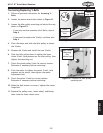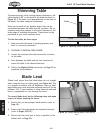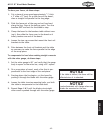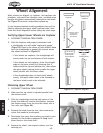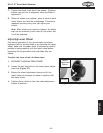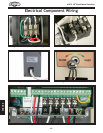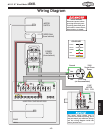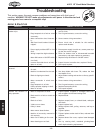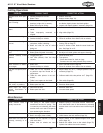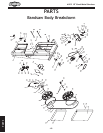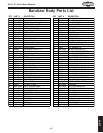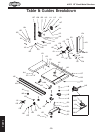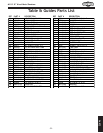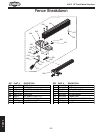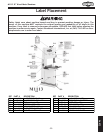
-47-
M1113 18" Wood/Metal Bandsaw
SERVICE
PROBLEM POSSIBLE CAUSE CORRECTIVE ACTION
Machine slows when oper-
ating.
1. Feeding workpiece too fast.
2. Blade is dull.
1. Reduce feed rate.
2. Replace blade (Page
34).
Ticking sound when the
saw is running.
1. Blade weld contacting guide/support
bearings (a light tick is normal).
2. Blade weld may be failing.
1. Use file or stone to smooth and round the back of
the blade; slightly loosen the blade guides.
2. Inspect and replace blade if necessary (Page
34).
Blade contacting table
insert.
1. Insert installed upside down or back
-
wards.
2. Table improperly mounted or
aligned.
1. Re-install insert a different way.
2. Align table (Page
23).
Vibration when cutting. 1. Loose or damaged blade.
2. Sawdust buildup on wheels.
1. Tighten or replace blade (Page
34).
2. Clean all sawdust from rubber tires on wheels.
Burn marks on the edge of
the cut.
1. Too much side pressure when feeding
workpiece; blade is binding.
2. Blade too wide for size of radius
being cut.
1. Feed workpiece straight into the blade. See Basic
Cutting Tips on Page
27.
2. Install a smaller width blade/increase blade ten
-
sion. See Page
34 or 19.
Rough or poor quality
cuts.
1. Feeding workpiece too fast.
2. Blade guides adjusted incorrectly.
1. Reduce feed rate.
2. Re-adjust all blade guides and support bearings.
Sawdust buildup inside
cabinet.
1. Clogged dust port.
2. Low CFM (airflow) from the shop
vacuum.
1. Clean out dust port.
2. Two options:
—Check dust hoses for leaks or clogs.
—Connect saw to a more powerful shop vacuum.
Blade wanders or doesn't
cut straight.
1. Blade lead.
2. Sawdust buildup on wheels.
1. Refer to Blade Lead on Page
40.
2. Clean all sawdust from rubber tires on wheels.
Cuts are not square (verti
-
cally).
1. Table tilt is not adjusted to 0˚
or positive stop has moved out of
adjustment.
2. Table tilt scale pointer is not cali
-
brated.
3. Table is not square to the blade.
1. Adjust table tilt to 0˚; readjust positive stop if
necessary (Page
22).
2. Calibrate table tilt scale pointer to 0˚ (Page
22).
3. Shim table (Page
40).
Metal chips are silvery,
thin, small, or powdery.
1. Feed rate too slow.
2. Blade speed too fast.
1. Increase feed rate.
2. Decrease blade speed.
Metal chips are large,
curled, blue/brown or
smoking.
1. Feed rate too fast.
2. Blade speed too slow.
1. Decrease feed rate.
2. Increase blade speed.
Cutting Operations
PROBLEM POSSIBLE CAUSE CORRECTIVE ACTION
Blade tension scale is
grossly inaccurate.
1. The spring in the blade tension
mechanism has lost its "spring." This
is caused by not releasing the blade
tension when not in use or frequently
over-tensioning the bandsaw.
1. Replace spring in the blade tension mechanism,
then take better care of the bandsaw by releasing
tension when not in use and not over-tensioning the
blade.
Wheel is noisy. 1. Wheel bearing is worn out.
2. Belt is too tight (lower wheel).
1. Replace the wheel bearing.
2. Check/loosen the belt tension (Page
38).
Blade does not track con
-
sistently, correctly, or at
all.
1. Wheels are not coplanar or aligned
with each other.
2. Rubber tires on wheels are worn
out.
1. Adjust wheels to be coplanar/aligned with each
other (Page
42).
2. Redress the rubber tires on the wheels (Page
37);
replace the rubber tires on the wheels.
Miscellaneous



